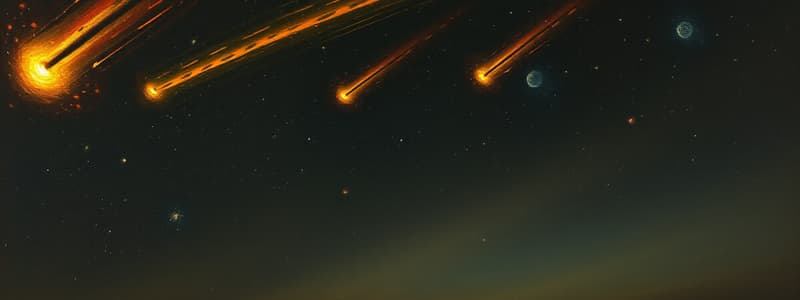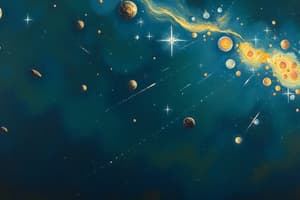Podcast
Questions and Answers
What distinguishes comets from asteroids in terms of composition?
What distinguishes comets from asteroids in terms of composition?
- Comets are exclusively made of silicate materials.
- Comets have a higher density than asteroids.
- Comets contain significant amounts of ice and volatile compounds. (correct)
- Comets are primarily composed of metal and rock.
Which of the following correctly identifies characteristics of meteors?
Which of the following correctly identifies characteristics of meteors?
- Meteors contain significant amounts of water and are predominantly gaseous.
- Meteors are small rocky bodies that originate from comets.
- Meteors are typically larger than asteroids and burn upon entering an atmosphere.
- Meteors are also known as shooting stars when they enter the Earth's atmosphere. (correct)
Which statement accurately reflects the nature of asteroids?
Which statement accurately reflects the nature of asteroids?
- Asteroids may vary significantly in size and are primarily composed of metals and rocky material. (correct)
- Asteroids are small celestial bodies that only exist in the inner solar system.
- Asteroids are predominantly found in the Kuiper Belt.
- Asteroids are only found between Mars and Jupiter.
What is the primary classification of celestial bodies among comets, meteors, and asteroids?
What is the primary classification of celestial bodies among comets, meteors, and asteroids?
Which of the following correctly describes the largest asteroid?
Which of the following correctly describes the largest asteroid?
Flashcards are hidden until you start studying
Study Notes
Comets
- Comets are icy bodies that, when close to the Sun, heat up and release gases, forming visible atmospheres called comas and sometimes tails.
- Comets originated from the outer regions of the solar system, particularly the Kuiper Belt and Oort Cloud.
Meteors
- Meteors are the streaks of light produced when meteoroids enter the Earth's atmosphere and burn up due to friction.
- If a meteoroid survives its passage through the atmosphere and lands on Earth, it is classified as a meteorite.
Asteroids
- Asteroids are rocky bodies that orbit the Sun, primarily found in the asteroid belt between Mars and Jupiter.
- The largest asteroid is Ceres, which is also classified as a dwarf planet with a diameter of approximately 940 kilometers.
Composition of Asteroids
- Asteroids are composed mainly of rock and metal, with some containing organic compounds and water ice.
- Their composition reflects the conditions of the early solar system, providing insights into planetary formation.
Studying That Suits You
Use AI to generate personalized quizzes and flashcards to suit your learning preferences.



